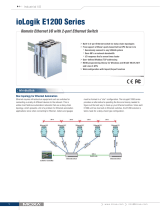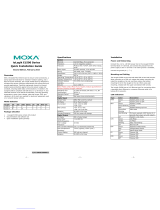
- 7 -
LED Indicators
Ready
Flashes every 1 sec when the “Locate”
function is triggered
Flashes every 0.5 sec when the firmware is
being upgraded
An on/off period cycle: 0.5 second shows
“Safe Mode”
Ethernet connection enabled
Transmitting or receiving data
Ethernet connection enabled
Transmitting or receiving data
(E1213 only)
EXT field power input is connected
EXT field power input is disconnected
System Configuration
Configuration via Web Console
Main configuration of an ioLogik E1200 is by web console.
• Default IP Address: 192.168.127.254
• Subnet Mask: 255.255.255.0
Be sure to configure the host PC’s IP address to the same subnet
as the ioLogik E1200. For example, 192.168.127.253
ioSearch Utility
ioSearch is a search utility that helps users locate an ioLogik E1200 on the
local network. The utility can be downloaded from Moxa’s website.
Load Factory Default Settings
There are three ways to restore the ioLogik E1200 to factory default
settings.
1. Hold the RESET button for 5 seconds.
2. In the ioSearch utility, right-click on the ioLogik device to be reset and
select Reset to Default.
3. Select Load Factory Default from the web console.
Please refer to the user's manual for detailed configuration and
settings information.












